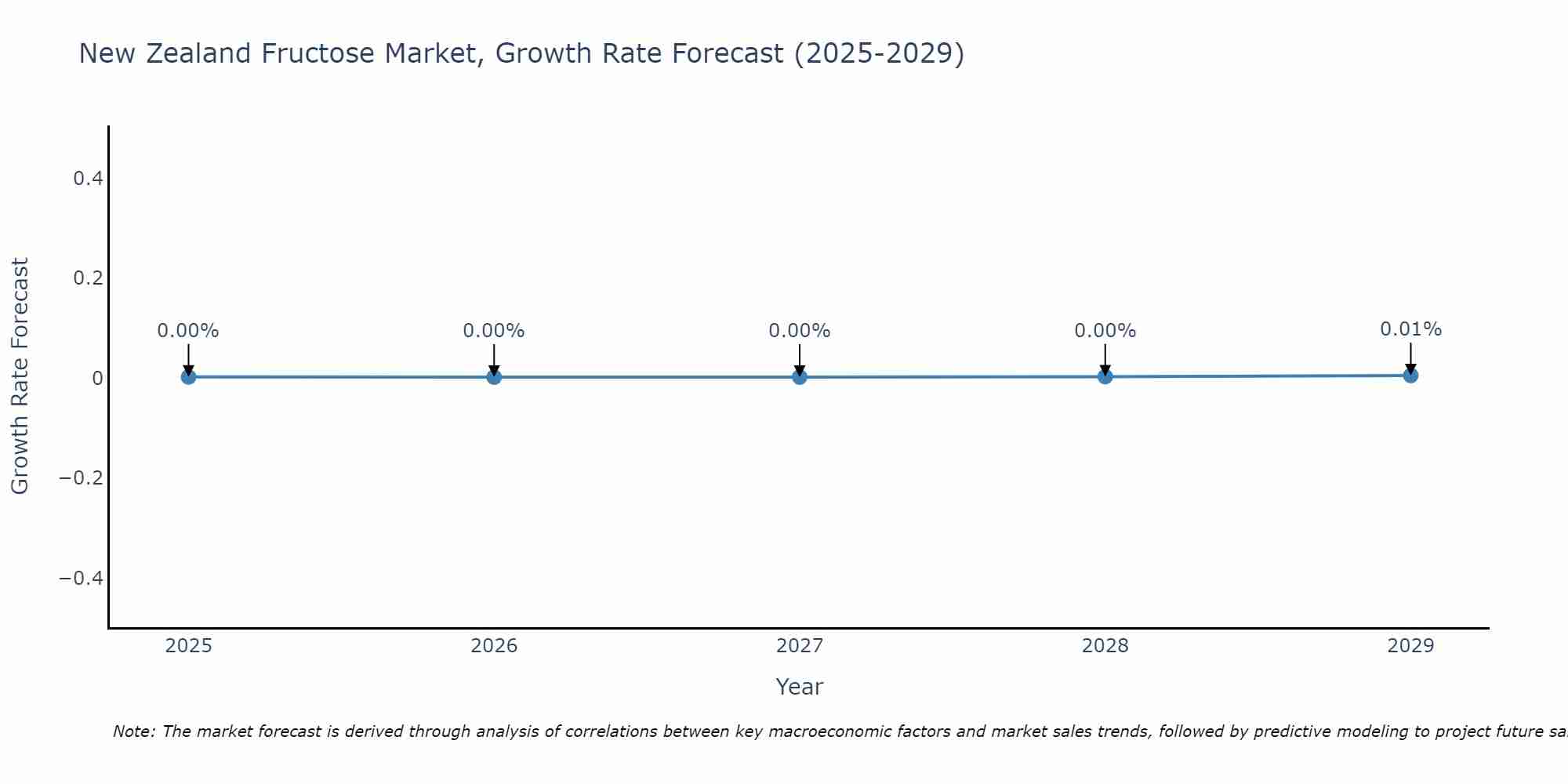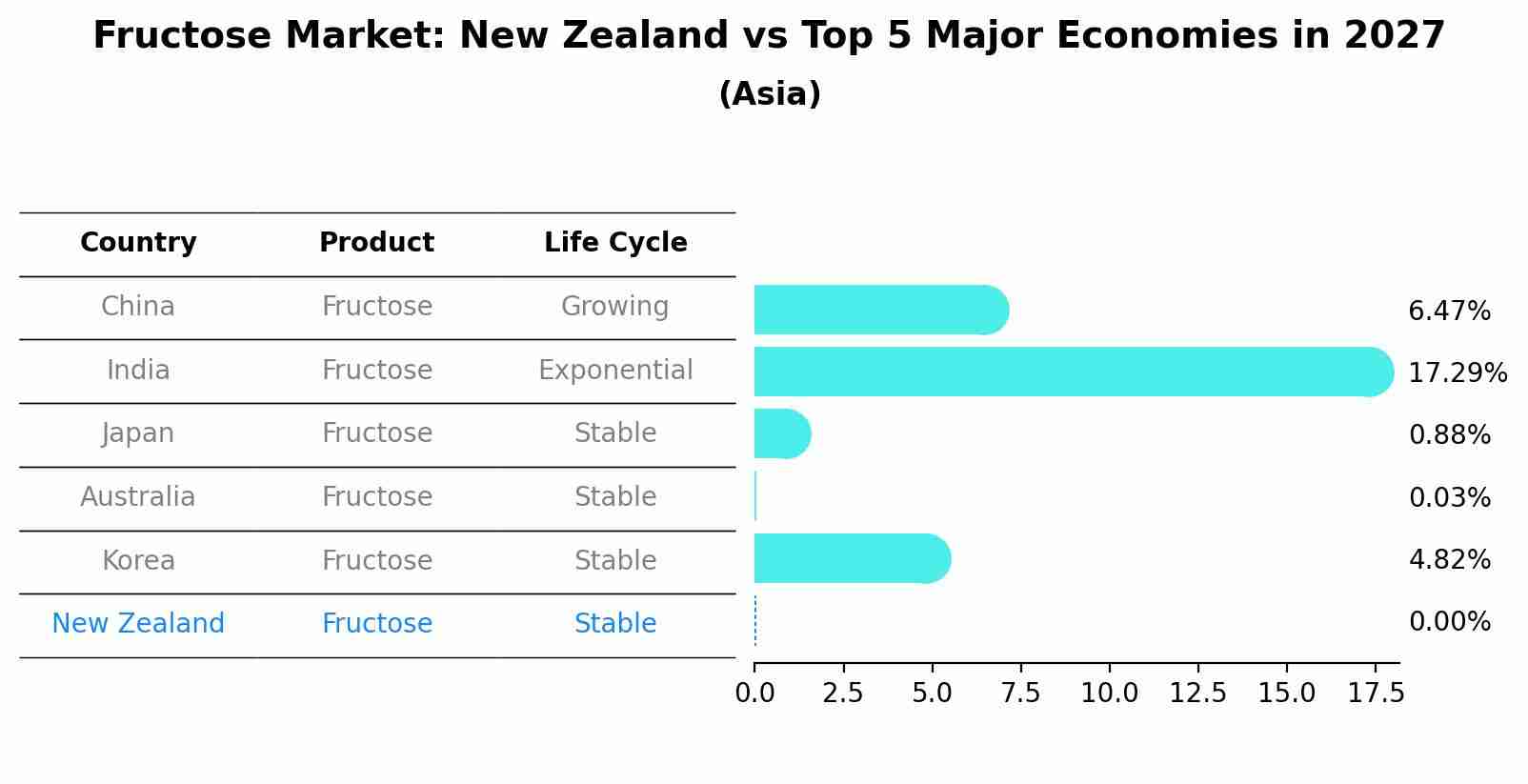New Zealand Fructose Market (2025-2031) | Companies, Forecast, Growth, Value, Revenue, Share, Industry, Segmentation, Analysis, Size, Trends & Outlook
| Product Code: ETC4733415 | Publication Date: Nov 2023 | Updated Date: Sep 2025 | Product Type: Market Research Report | |
| Publisher: 6Wresearch | No. of Pages: 60 | No. of Figures: 30 | No. of Tables: 5 | |
New Zealand Fructose Market Size Growth Rate
The New Zealand Fructose Market is projected to witness mixed growth rate patterns during 2025 to 2029. From 0.00% in 2025, the growth rate steadily ascends to 0.01% in 2029.

Fructose Market: New Zealand vs Top 5 Major Economies in 2027 (Asia)
In the Asia region, the Fructose market in New Zealand is projected to expand at a stable growth rate of 0.00% by 2027. The largest economy is China, followed by India, Japan, Australia and South Korea.

Key Highlights of the Report:
- New Zealand Fructose Market Outlook
- Market Size of New Zealand Fructose Market, 2024
- Forecast of New Zealand Fructose Market, 2031
- Historical Data and Forecast of New Zealand Fructose Revenues & Volume for the Period 2021-2031
- New Zealand Fructose Market Trend Evolution
- New Zealand Fructose Market Drivers and Challenges
- New Zealand Fructose Price Trends
- New Zealand Fructose Porter`s Five Forces
- New Zealand Fructose Industry Life Cycle
- Historical Data and Forecast of New Zealand Fructose Market Revenues & Volume By Product for the Period 2021-2031
- Historical Data and Forecast of New Zealand Fructose Market Revenues & Volume By High Fructose Corn Syrup for the Period 2021-2031
- Historical Data and Forecast of New Zealand Fructose Market Revenues & Volume By Fructose Syrups for the Period 2021-2031
- Historical Data and Forecast of New Zealand Fructose Market Revenues & Volume By Fructose Solids for the Period 2021-2031
- Historical Data and Forecast of New Zealand Fructose Market Revenues & Volume By Application for the Period 2021-2031
- Historical Data and Forecast of New Zealand Fructose Market Revenues & Volume By Beverages for the Period 2021-2031
- Historical Data and Forecast of New Zealand Fructose Market Revenues & Volume By Processed Foods for the Period 2021-2031
- Historical Data and Forecast of New Zealand Fructose Market Revenues & Volume By Dairy Products for the Period 2021-2031
- Historical Data and Forecast of New Zealand Fructose Market Revenues & Volume By Confectionary for the Period 2021-2031
- Historical Data and Forecast of New Zealand Fructose Market Revenues & Volume By Bakery & Cereals for the Period 2021-2031
- Historical Data and Forecast of New Zealand Fructose Market Revenues & Volume By Others for the Period 2021-2031
- New Zealand Fructose Import Export Trade Statistics
- Market Opportunity Assessment By Product
- Market Opportunity Assessment By Application
- New Zealand Fructose Top Companies Market Share
- New Zealand Fructose Competitive Benchmarking By Technical and Operational Parameters
- New Zealand Fructose Company Profiles
- New Zealand Fructose Key Strategic Recommendations
Frequently Asked Questions About the Market Study (FAQs):
1 Executive Summary |
2 Introduction |
2.1 Key Highlights of the Report |
2.2 Report Description |
2.3 Market Scope & Segmentation |
2.4 Research Methodology |
2.5 Assumptions |
3 New Zealand Fructose Market Overview |
3.1 New Zealand Country Macro Economic Indicators |
3.2 New Zealand Fructose Market Revenues & Volume, 2021 & 2031F |
3.3 New Zealand Fructose Market - Industry Life Cycle |
3.4 New Zealand Fructose Market - Porter's Five Forces |
3.5 New Zealand Fructose Market Revenues & Volume Share, By Product, 2021 & 2031F |
3.6 New Zealand Fructose Market Revenues & Volume Share, By Application, 2021 & 2031F |
4 New Zealand Fructose Market Dynamics |
4.1 Impact Analysis |
4.2 Market Drivers |
4.2.1 Increasing consumer awareness about health benefits of low-glycemic sweeteners like fructose |
4.2.2 Growing demand for natural and clean label food ingredients |
4.2.3 Rising prevalence of lifestyle diseases such as diabetes, prompting consumers to seek healthier alternatives |
4.3 Market Restraints |
4.3.1 Concerns regarding the impact of excessive fructose consumption on metabolic health |
4.3.2 Competition from other low-glycemic sweeteners such as stevia and erythritol |
4.3.3 Fluctuations in raw material prices affecting production costs |
5 New Zealand Fructose Market Trends |
6 New Zealand Fructose Market Segmentations |
6.1 New Zealand Fructose Market, By Product |
6.1.1 Overview and Analysis |
6.1.2 New Zealand Fructose Market Revenues & Volume, By High Fructose Corn Syrup, 2021-2031F |
6.1.3 New Zealand Fructose Market Revenues & Volume, By Fructose Syrups, 2021-2031F |
6.1.4 New Zealand Fructose Market Revenues & Volume, By Fructose Solids, 2021-2031F |
6.2 New Zealand Fructose Market, By Application |
6.2.1 Overview and Analysis |
6.2.2 New Zealand Fructose Market Revenues & Volume, By Beverages, 2021-2031F |
6.2.3 New Zealand Fructose Market Revenues & Volume, By Processed Foods, 2021-2031F |
6.2.4 New Zealand Fructose Market Revenues & Volume, By Dairy Products, 2021-2031F |
6.2.5 New Zealand Fructose Market Revenues & Volume, By Confectionary, 2021-2031F |
6.2.6 New Zealand Fructose Market Revenues & Volume, By Bakery & Cereals, 2021-2031F |
6.2.7 New Zealand Fructose Market Revenues & Volume, By Others, 2021-2031F |
7 New Zealand Fructose Market Import-Export Trade Statistics |
7.1 New Zealand Fructose Market Export to Major Countries |
7.2 New Zealand Fructose Market Imports from Major Countries |
8 New Zealand Fructose Market Key Performance Indicators |
8.1 Consumer acceptance and adoption rate of products containing fructose |
8.2 Number of new product launches featuring fructose as a key ingredient |
8.3 Research and development investments in fructose-based product innovation |
8.4 Consumer perception surveys on the benefits and drawbacks of fructose consumption |
8.5 Regulatory developments and changes impacting the fructose market in New Zealand |
9 New Zealand Fructose Market - Opportunity Assessment |
9.1 New Zealand Fructose Market Opportunity Assessment, By Product, 2021 & 2031F |
9.2 New Zealand Fructose Market Opportunity Assessment, By Application, 2021 & 2031F |
10 New Zealand Fructose Market - Competitive Landscape |
10.1 New Zealand Fructose Market Revenue Share, By Companies, 2024 |
10.2 New Zealand Fructose Market Competitive Benchmarking, By Operating and Technical Parameters |
11 Company Profiles |
12 Recommendations | 13 Disclaimer |
- Single User License$ 1,995
- Department License$ 2,400
- Site License$ 3,120
- Global License$ 3,795
Search
Related Reports
- ASEAN and Thailand Brain Health Supplements Market (2025-2031) | Strategy, Consumer Insights, Analysis, Investment Trends, Opportunities, Growth, Size, Share, Industry, Revenue, Segments, Value, Segmentation, Supply, Forecast, Restraints, Outlook, Competition, Drivers, Trends, Demand, Pricing Analysis, Competitive, Strategic Insights, Companies, Challenges
- ASEAN Bearings Market (2025-2031) | Strategy, Consumer Insights, Analysis, Investment Trends, Opportunities, Growth, Size, Share, Industry, Revenue, Segments, Value, Segmentation, Supply, Forecast, Restraints, Outlook, Competition, Drivers, Trends, Demand, Pricing Analysis, Competitive, Strategic Insights, Companies, Challenges
- Europe Flooring Market (2025-2031) | Outlook, Share, Industry, Trends, Forecast, Companies, Revenue, Size, Analysis, Growth & Value
- Saudi Arabia Manlift Market (2025-2031) | Outlook, Size, Growth, Trends, Companies, Industry, Revenue, Value, Share, Forecast & Analysis
- Uganda Excavator, Crane, and Wheel Loaders Market (2025-2031) | Strategy, Consumer Insights, Analysis, Investment Trends, Opportunities, Growth, Size, Share, Industry, Revenue, Segments, Value, Segmentation, Supply, Forecast, Restraints, Outlook, Competition, Drivers, Trends, Demand, Pricing Analysis, Competitive, Strategic Insights, Companies, Challenges
- Rwanda Excavator, Crane, and Wheel Loaders Market (2025-2031) | Strategy, Consumer Insights, Analysis, Investment Trends, Opportunities, Growth, Size, Share, Industry, Revenue, Segments, Value, Segmentation, Supply, Forecast, Restraints, Outlook, Competition, Drivers, Trends, Demand, Pricing Analysis, Competitive, Strategic Insights, Companies, Challenges
- Kenya Excavator, Crane, and Wheel Loaders Market (2025-2031) | Strategy, Consumer Insights, Analysis, Investment Trends, Opportunities, Growth, Size, Share, Industry, Revenue, Segments, Value, Segmentation, Supply, Forecast, Restraints, Outlook, Competition, Drivers, Trends, Demand, Pricing Analysis, Competitive, Strategic Insights, Companies, Challenges
- Angola Excavator, Crane, and Wheel Loaders Market (2025-2031) | Strategy, Consumer Insights, Analysis, Investment Trends, Opportunities, Growth, Size, Share, Industry, Revenue, Segments, Value, Segmentation, Supply, Forecast, Restraints, Outlook, Competition, Drivers, Trends, Demand, Pricing Analysis, Competitive, Strategic Insights, Companies, Challenges
- Israel Intelligent Transport System Market (2025-2031) | Strategy, Consumer Insights, Analysis, Investment Trends, Opportunities, Growth, Size, Share, Industry, Revenue, Segments, Value, Segmentation, Supply, Forecast, Restraints, Outlook, Competition, Drivers, Trends, Demand, Pricing Analysis, Competitive, Strategic Insights, Companies, Challenges
- Uganda Precast and Aggregate Market (2025-2031) | Strategy, Consumer Insights, Analysis, Investment Trends, Opportunities, Growth, Size, Share, Industry, Revenue, Segments, Value, Segmentation, Supply, Forecast, Restraints, Outlook, Competition, Drivers, Trends, Demand, Pricing Analysis, Competitive, Strategic Insights, Companies, Challenges
Industry Events and Analyst Meet
Our Clients
Whitepaper
- Middle East & Africa Commercial Security Market Click here to view more.
- Middle East & Africa Fire Safety Systems & Equipment Market Click here to view more.
- GCC Drone Market Click here to view more.
- Middle East Lighting Fixture Market Click here to view more.
- GCC Physical & Perimeter Security Market Click here to view more.
6WResearch In News
- Doha a strategic location for EV manufacturing hub: IPA Qatar
- Demand for luxury TVs surging in the GCC, says Samsung
- Empowering Growth: The Thriving Journey of Bangladesh’s Cable Industry
- Demand for luxury TVs surging in the GCC, says Samsung
- Video call with a traditional healer? Once unthinkable, it’s now common in South Africa
- Intelligent Buildings To Smooth GCC’s Path To Net Zero













